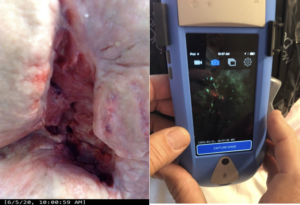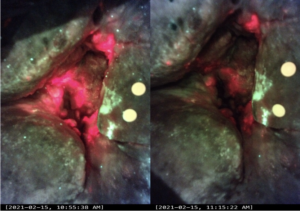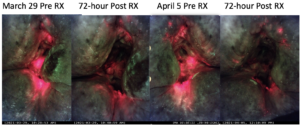
Jet Lavage Irrigation of Severe Chronic Pelvic Pressure Injury With Modified Sodium Hypochlorite
By Dr. James B Stiehl MD MBA FAAOS, St Mary’s Hospital, Centralia, Illinois
Introduction:
Difficult chronic sacral pelvic pressure injuries can pose a challenge to medical providers in terms of therapeutic choices. We have studied daily jet lavage irrigation in the outpatient setting finding excellent safety and wound cleansing compared to the standard of care. This report assess the addition of antiseptic as a low pressure irrigated fluid.
Method:
A 72-year-old male has a large stage 4 pelvic pressure injury over the sacrum for 8 years. After surgical debridement, he was entered into an investigational study where the wound was treated daily (ave. 5 days/week) with low pressure jet lavage (8 PSI) irrigation with 3 liters of fluid (IRB #6066, Sterling Investigational Review Board, Atlanta, GA). After 13 months treatment, we noticed that wound cleansing was not complete with our protocol.(Fig 2) We added modified sodium hypochlorite to the irrigation and assessed wounds with autofluorescence digital imaging (MolecuLight, Inc. Toronto, CA)
Fig. 1 Stage 4 PPI with MolecuLight exam

Fig 2. 72-hour delay RX has incomplete removal of biofilm bacteria with irrigation

Fig. 3 Jet lavage with modified sodium hypochlorite

Results:
After a long weekend 72-hour delay in treatment, MolecuLight image reveals near complete removal of bacterial bioburden in most examples. This implies that the reduction from >log 4 bacteria/gram tissue is reduced to <log 2. (Fig 3) After 250 treatments, there have been no recognized complications with irrigating sodium hypochlorite through the irrigator at 8 PSI pressure.
Conclusion:
Adding antimicrobial irrigation jet lavage irrigation for selective mechanical debridement is a safe and incremental improvement for early wound bed prep.
References:
1. Ho C., el.al. Pulsatile lavage for the enhancement of pressure ulcer healing: A randomized controlled trial. Physical Therapy 2012; 92: 38-48.
